Biography Biographie
1980
Moves to Walferdange and marries Marie-José Meyers.
1980 — 1988
Art teacher at the Lycée Technique Nic-Biever in Dudelange and the Lycée Technique des Arts et Métiers in Luxembourg City.
1982
1983
His first son, David Michels, is born.
Wins the “Prix de la Peinture” at the XIe Biennale de la Peinture et de la Sculpture des Jeunes in Esch-sur-Alzette and a six-week artist residency at Cité des Arts in Paris.
Gast Michels in his studio in Walferdange. © Unknown photographer, c. 1991
12
1983 — 1984
First solo exhibitions at Galerie Tetra in Wavre and Librairie Gutenberg in Brussels, Belgium.
1984
1985
1987
His second son, Frank Michels, is born.
First solo exhibition in Luxembourg at Galerie d’Art Municipale in Esch-sur-Alzette.
Wins the “Prix de Raville“ for the work Arc/Flèche at the annual Salon du CAL. This marks the beginning of the artist’s characteristic use of styl ised symbols such as arrows, arcs and wheels.
1988
Michels gives up teaching and begins to work as an independent painter, sculptor and graphic art ist. He has the first of numerous solo exhibitions at the Galerie de Luxembourg, whose owner Jean Aulner is a close friend of his.
1994
Michels discovers a new creative tool for his work: the computer.
1996 Michels’ wife, Marie-José Michels-Meyers (1946 — 1996), dies. Michels designs temporary flags for the station tower on the occasion of the CFL’s 50th anniversary.
1998
Creates his first series of metal sculptures, Steel drawings, after almost 8 years of dedicating himself exclusively to painting.
1954
2000
Retrospective exhibition at Théâtre Galerie d’Esch: 1980 — 2000 vingt ans d’aventure picturale.
2002 — 2011
Regular solo exhibitions at Espace Mett Goedert in Consdorf.
Gaston François Michels est né le 11 janvier 1954 à Echternach, Luxembourg. Le Mullerthal deviendra une source d’inspiration essentielle dans son travail.
1960 — 1972
Ecole primaire à Consdorf, ensuite Lycée Classique d’Echternach pour l’enseignement secondaire.
1974 — 1980
2006
Creates a 258-m2-mural, Atmosphère urbaine, for the Administration communale de la Ville de Luxembourg (Rocade 3).
Études à l’École Supérieure des Arts Saint-Luc à Liège, Belgique.
2009
2011
2013
Moves to Vaison-la-Romaine in Provence, France with his partner Yvette Tosseng.
Begins blood cancer treatment in Marseille, France.
Dies on 5 February 2013 in Marseille, France.
1980
Michels s’installe à Walferdange et épouse Marie-José Meyers.
1980 — 1988
Professeur d’éducation artistique au Lycée technique Nic-Biever à Dudelange et au Lycée Technique des Arts et Métiers à Luxembourg-Ville.
1982
1983
Naissance de son premier fils, David Michels.
Lauréat du Prix de la Peinture à la XIe Biennale de la Peinture et de la Sculpture des Jeunes à Esch-sur-Alzette et résidence d’artiste de six semaines à la Cité des Arts de Paris.
4 Audry, R.: Chronique des créateurs: Gast Michels Entre la chute et l’élévation, Tageblatt, August 1985, n. pag.
5 Michels, G., in: Welter, R.: Interview avec Gast Michels / Gespräch mit Gast Michels, Revue culturelle “Estuaires”, n° 6, 1988, p. 41 : “[…], j’ai parcouru pendant mon enfance les grottes, les gorges, les gigantesques falaises aux formes bizarres et oniriques dans mes forêts de la région de Consdorf. Face au ’riche silence blanc’ d’une toile ce décor fantastique et baroque en été, sobre et mystérieux en hiver, se condense en signes pour prendre forme et signification.”
6 Kolberg, G.: Über die Natur der Werke von Gast Michels, in: Gast Michels, Galerie de Luxembourg, 1991, Luxembourg, p. 79.
7 Schneider, J.P.: Gast Michels, homme des forêts, Luxemburger Wort, October 1989, n. pag.
8 Michels, G., in: Welter, R.: Interview avec Gast Michels / Gespräch mit Gast Michels, Revue culturelle “Estuaires”, n° 6, 1988, p. 42.
9 In the interview with René Welter in 1988, the artist points out that his initial inspiration for the use of the cross came from a cross engraving in a rock in Loschbur (near Consdorf), which dates back to at least 1800 BC.
After graduating from the École Supérieure des Arts Saint-Luc in Liège in 1980, Michels moved to Walferdange, where he set up his studio in a former mill and started working as an art teacher in a secondary school in Dudelange. Some of the earliest works in the exhibition date from this period (no. 7, 18) and demonstrate how Michels adopted an expressionistic graphic style and a vibrant colour palette early on. While figurative elements are prevalent in these early works, they already allude to some of Michels’ typical motifs and stylistic features, e.g. the use of symbols (in this case, the cross) or the layering of monochromatic planes of colour. They also feature the artist’s bold, expressive brushstrokes, which almost make you feel the movement of his hand across the canvas. In works such as Fortress (1984) (no. 20) or his depiction of the Schiessentümpel (1985) (no. 22), fragmented surfaces of colour blend into one another, creating shapes and forms inspired by real life. In 1985, Rich Audry referred to Michels’ style as “l’art le de la figuration brute” 4, the art of raw figuration, which he describes as an expressionistic and honest way of painting, one that seeks to be as close to reality as possible and avoids any deceptive alterations to real life. Indeed, Michels’ style is very straightforward and direct, merging the portrayal of reality and the artist’s own view of the world into power ful paintings.
The forest man
Michels grew up amidst the mystical forest landscapes and rock formations of the Mullerthal. As a young boy he loved to explore the woodlands of Consdorf and was mesmerised by the surreal shapes of the caves and gorges he found there.5 The artist’s ties to the Muller thal prompted him to develop a deep fascina tion with nature, which served as a key source of inspiration throughout his artistic career. Michels’ art is informed by a keen interest in the historical and natural qualities of these landscapes and often reveals a “tendency to venture back to the roots of […] the ’Ursprünglichkeit’ (’nativeness’)”6. His works portray nature as a mystical remnant from a bygone era when man’s relationship to nature was very different from what it is today. Within the Luxembourgish art scene, Michels thus quickly came to be known as “l’homme des forêts”7, the forest man.
Starting in the late 1980s, Michels began to incorporate symbols, often reminiscent of prehistoric cave paintings, into his art. The symbols he used carry certain meanings and often have a specific function within the overall composition of the artwork. Hence, the axe and the shield, the arch and the arrow serve as symbols of battle and protection, the tree as a symbol of life and the deer and the hunter as a representation of the good and the bad, the rational and the irrational.8 The cross, another recurring symbol in Michels’ art, is a representation of life, a symbol of vitality.9 As art historian Gerhard Kolberg rightly points
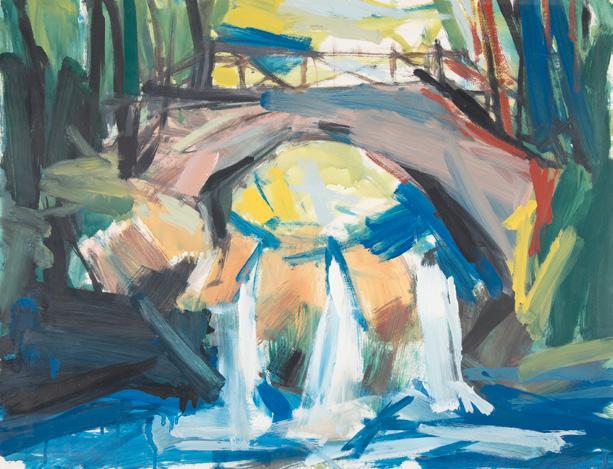
22 Untitled, c. 1985 Acrylic on paper 50 x 65 cm Gast Michels Estate

32 Créatures, 1994 Aubusson tapestry 250 x 400 cm Banque et Caisse d’Epargne de l’Etat
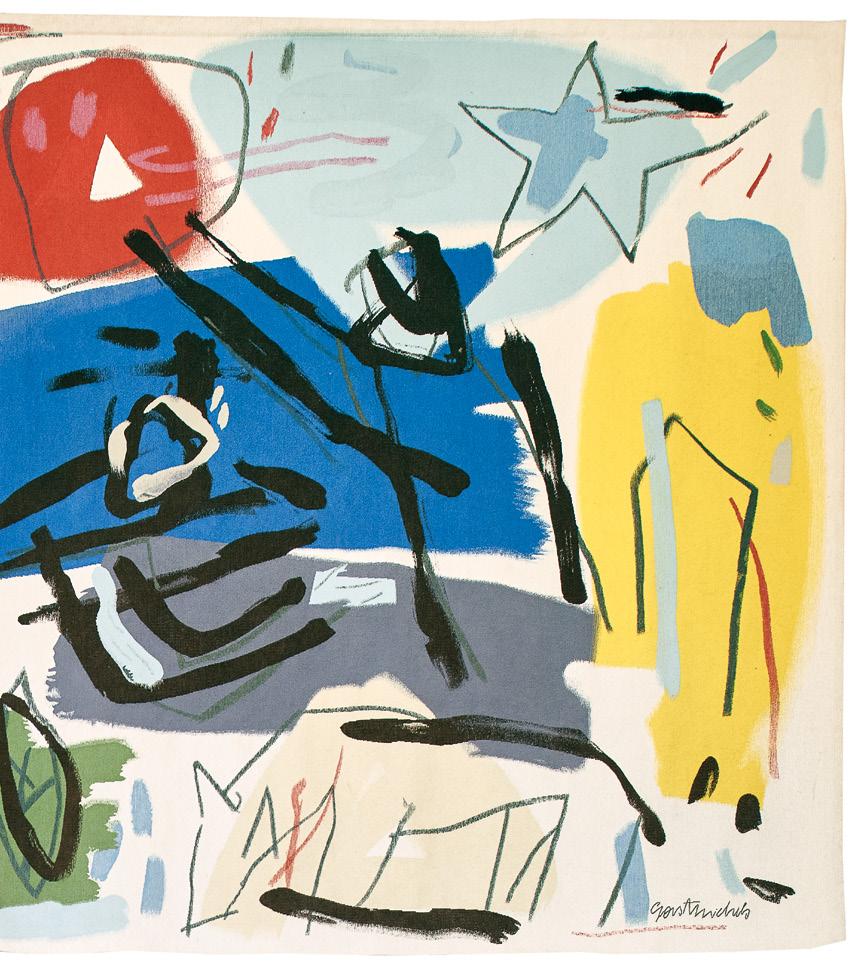
49
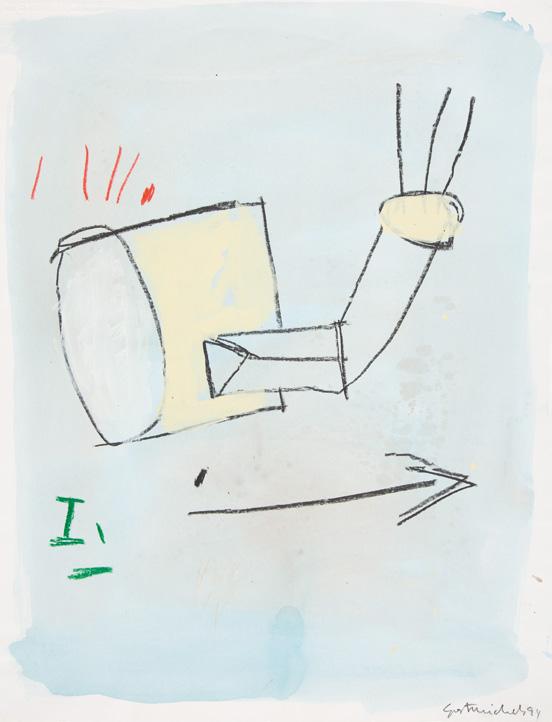
43 Pièce de réchange II, 1994 Acrylic and oilstick on paper 65 x 50 cm Gast Michels Estate

59 44 Chapeau mongolien, 1994 Acrylic on paper 50 x 63 cm Gast Michels Estate
57 Roue et flèche, 2009
Bronze x 6 x 4 cm
Gast Michels Estate
Y au losange, 2009
Bronze x 12 x 6 cm
Gast Michels Estate
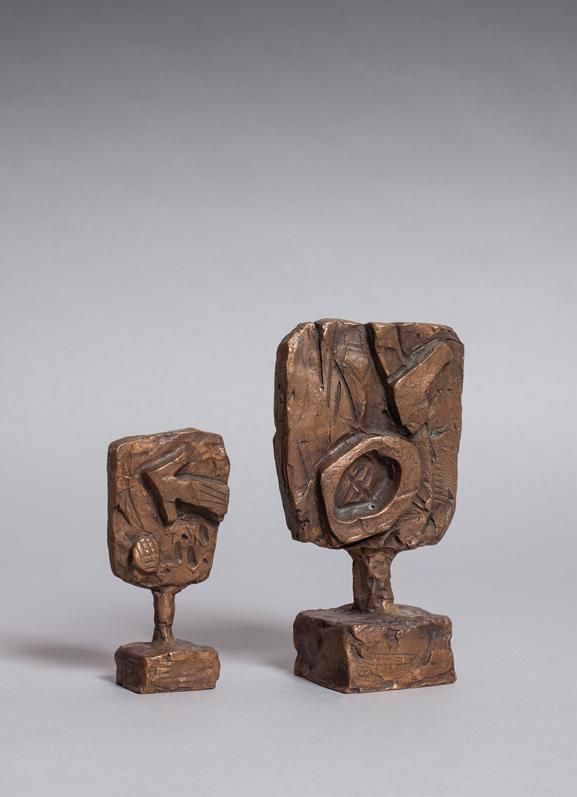
76
14
20
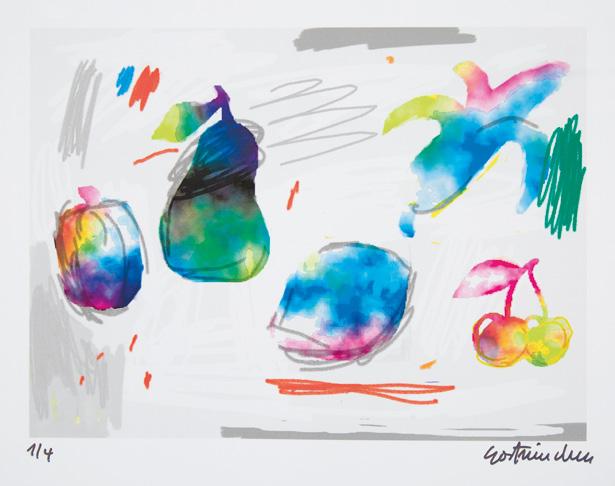
87 73 Untitled, c. 2002 Digital print on glossy paper 40 x 50 cm Gast Michels Estate
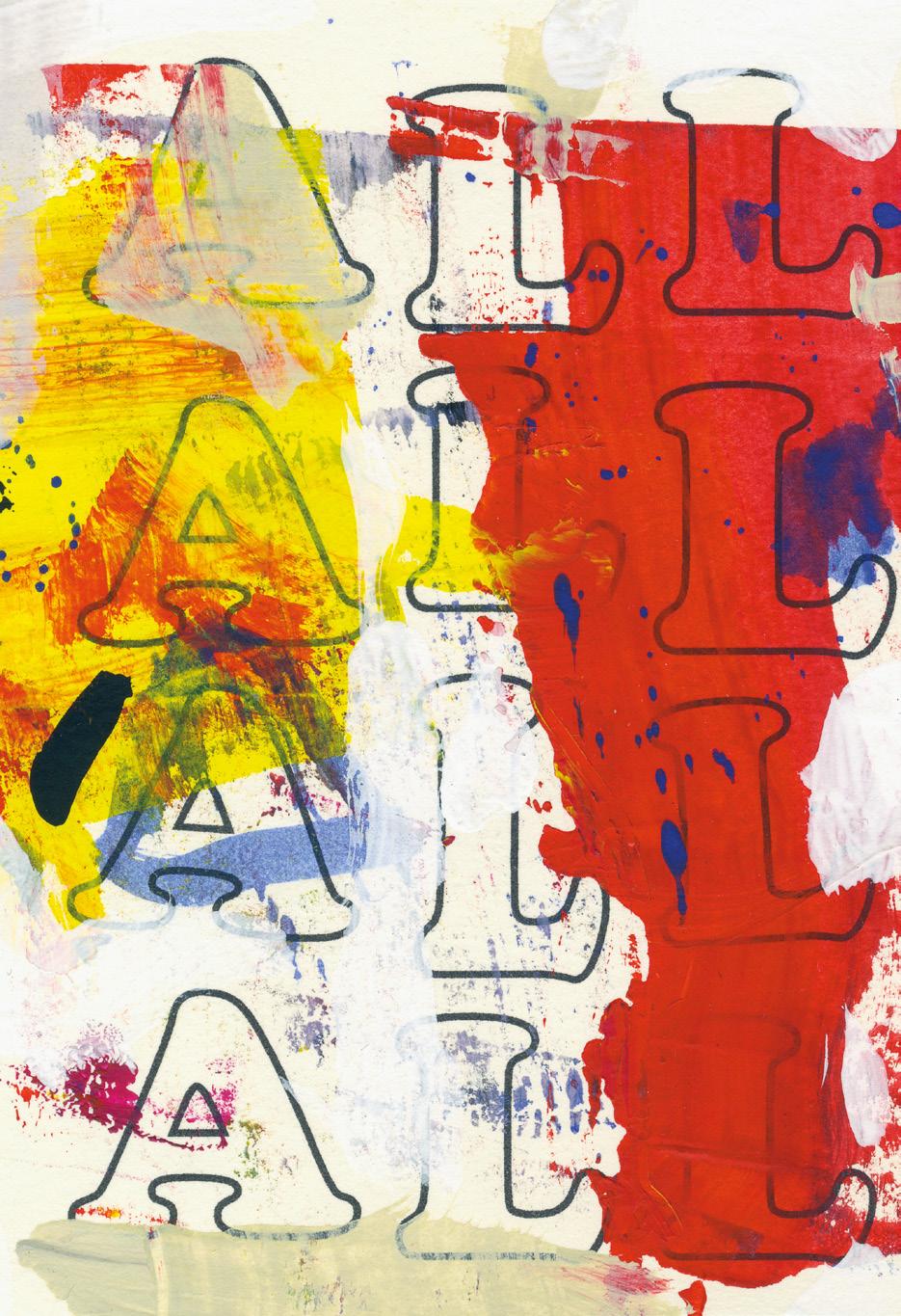


86 Untitled, c. 2009 Acrylic on loose canvas 75 x 55 cm Gast Michels Estate
This book was published on the occasion of the exhibition Gast Michels (1954 — 2013): Movement in colour, form and symbols
7 October 2022 26 March 2023 at the MNHA
7 October 2022 22 January 2023 at the Cercle Cité
Ce livre a été publié à l’occasion de l’exposition Gast Michels (1954 2013) : Movement in colour, form and symbols
7 octobre 2022 26 mars 2023 au MNHA
7 octobre 2022 22 janvier 2023 au Cercle Cité
Acknowledgments / Remerciements
The National Museum of History and Art and the Cercle Cité would like to express their gra titude to everyone who made this project possible through their generous loans and support:
Gast Michels Estate Banque et Caisse d’Epargne de l’Etat Les 2 Musées de la Ville de Luxembourg and all private collectors.
A special thanks goes to Frank and David Michels for their collaboration and dedica tion throughout this entire project.
Le Musée national d’histoire et d’art et le Cercle Cité remercient vivement toutes les per sonnes qui par leur concours et leurs prêts ont permis de réaliser la présente exposition :
Gast Michels Estate Banque et Caisse d’Epargne de l’Etat Les 2 Musées de la Ville de Luxembourg et tous les prêteurs privés.
Nous tenons à remercier tout particuliè rement Frank et David Michels pour leur collaboration et leur engagement tout au long de ce projet.
Photo credits / Crédits photographiques
pp. 2–3 | p. 9–10 | p. 15 | p. 18 | p. 20 | p. 22 | p. 25 | p. 27 | p. 29 | pp. 31–36 | pp. 38–47 | pp. 50–106 | p. 109
Gast Michels Estate, Frank Michels
p. 23 | p. 27 | p. 37 | pp. 48–49 | p. 109 MNHA, Tom Lucas p. 9
Jochen Herling
All copyright owners have been carefully researched to the best of our knowledge. If you believe that any existing copyright has not been taken into account, please feel free to contact the MNHA. All justified requests will be considered in accordance with the terms and conditions in place.
MNHA Marché-aux-Poissons L–2345 Luxembourg www.mnha.lu
Cercle Cité Place d’Armes L–2012 Luxembourg www.cerclecite.lu
Les détenteurs des copyrights ont été recherchés avec grand soin de notre part. N’hésitez pas à contacter le MNHA en cas d’un droit d’image non considéré. Toute demande dûment justifiée sera prise en compte selon les modalités en vigueur.
The Luxembourgish artist Gast Michels (1954 — 2013) was a remarkably keen observer of his environment. He meticulously analysed and decoded his surroundings, translating them into his own formal universe. Michels’ oeuvre has a unique formal language and features recurring symbols like wheels or arrows and a luminous colour palette, often dominated by the complementary colours blue and yellow. While the early work of the Echternach-born artist predominantly deals with seemingly mythical depictions of human figures in woodland settings, his later works have a more graphic pictorial language featuring highly stylised objects and signs. As a painter, sculptor and graphic artist, Michels worked in various mediums but always remained true to his expressive, symbolic and at times humorous and ironic visual language.
2022 ISBN 978–2–87985–773–2
